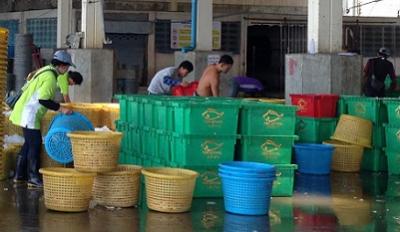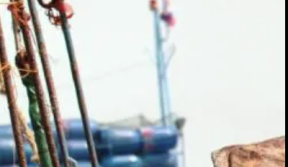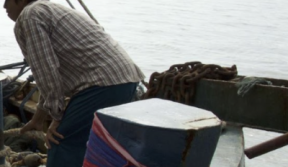
Nine workers from Ghana, India and Sri Lanka, were rescued from a U.K-flagged fishing vessel this month in a likely case of labor trafficking. They had been forced to work for months on end with no defined rest periods, for a little over $1,000 a month. Exploitation of migrant workers on fishing vessels has been documented in the fleets of a number of the world’s largest seafood exporters, including Taiwan, South Korea, Thailand, Indonesia and even the United States.
Thailand has been the subject of intense international pressure after a series of high-profile exposés in 2015 and 2016 revealed human trafficking and horrific worker abuse on Thai-flagged vessels. Since then, Thailand has become an incubator of sorts for solutions to rid seafood supply chains of these abuses. Funding has poured in from foundations, governments and industry actors, all trying to develop tools for labor inspectors on fishing vessels and companies to prevent, identify and/or ameliorate forced labor on fishing vessels. Many of these actors have implicit or explicit goals of refining these tools in Thailand for ultimate use in other countries around the world.
One of the most prominent of these initiatives, the Seafood Taskforce, released a report a few weeks ago outlining its activities, with newly-developed key performance indicators and measurement toward fulfillment of its objectives. This industry-led effort has an ambitious platform for changing the Thai seafood supply chain. This is important work, particularly its efforts to increase traceability and transparency, which is necessary for government and industry actors to improve enforcement of both environmental and labor law.
These are important steps, but missing one important element: inclusion of workers. The social auditing solution proposed by the Seafood Taskforce and other industry- and government-led social sustainability programs has been shown to be ineffective by decades of research into such efforts in multiple countries and sectors. This research has brought a growing and diverse number of stakeholders to insist that workers must have a substantial role in identifying and stopping human rights abuses in global supply chains. Only with workers’ organizations fully engaged in the governance and implementation of such programs can grievance mechanisms become effective and access to remedy be secured.
Access to remedy was the theme of the 2017 United Nations Forum on Business and Human Rights convened last month in Geneva. A paper from the Working Group on the Issue of Human Rights and Transnational Corporations and Other Business Enterprises within the Office of the United Nations High Commissioner for Human Rights released in advance of the Forum unpacks the concept of access to effective remedies under the U.N. Guiding Principles on Business and Human Rights (UNGPs). The report finds that, “Rights holders should be central to the entire remedy process…All [remedial] mechanisms should be at the service of rights holders, who should be consulted meaningfully in creating, designing, reforming and operating such mechanisms.”
As sound as this guidance is, it is difficult to implement on fishing vessels, which often operate for weeks and months at a time isolated on open seas where communication may not be possible. Low unionization rate is the key factor behind the appalling working conditions and low wages that prevail in the seafood sector, according to the International Union of Foodworkers (IUF). ILRF is developing strategies to implement this guidance in the seafood sector with its Independent Monitoring at Sea (IM @ SEA) project. A report scheduled for release in early 2018 will detail more fully challenges and successes in establishing worker-led workplace monitoring and legally binding agreements with employers. In advance of the report, ILRF has drafted four Essential Elements of Social Responsibility in the Seafood Sector, based on ILRF’s decades of work documenting and analyzing the failures of conventional corporate social responsibility mechanisms in sectors including apparel, cocoa, and palm oil. In brief, they are:
- Genuine worker representation
Workers, and their unions or other representative organizations, should be involved in all stages of design, training, implementation and governance of social responsibility projects. Real-time worker-driven monitoring at sea is essential in the marine capture fisheries sector, and requires access to electronic communication at-sea and an around-the-clock worker-driven complaints mechanism. - Comprehensive and transparent risk assessment and verification of workplace compliance
Effective risk assessment and verification against international labor rights standards of workplace compliance requires comprehensive, in-depth interviews with workers, conducted in a safe place by interviewers well-versed in local and sectoral risks. Transparency in the reporting of violations, status of complaints and outcomes of dispute resolution processes is also essential to ensure compliance. - Legally-binding and enforceable agreements
Workers rights are not optional and must be embedded in contracts and a means to hold employers and others in the supply chain accountable. These legal agreements should clearly articulate the rights and responsibilities of each party and dispute resolution procedure, as well as provisions that guarantee an effective grievance mechanism, and zero tolerance for reprisals. - Change brand purchasing practices
Buyers must analyze, address and make changes to their purchasing practices – price negotiation, etc. - so that they don’t contribute to human rights violations, but instead actively support and incentivize suppliers in remediating them. This includes supply chain transparency down to the vessel level.
As influencers in the seafood sector begin to tackle labor exploitation in their supply chains, it is important to learn from the experience of similar efforts in other sectors. Starting with a top-down, industry led approach was the model of 30 years ago, and has been shown not to work. The thinking today is moving toward more sustainable, worker-driven models that should be the baseline from which social sustainability programs in the seafood sector should start.


